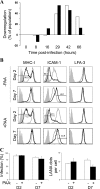Intracellular Kaposi's sarcoma-associated herpesvirus load determines early loss of immune synapse components
- PMID: 17329329
- PMCID: PMC1900224
- DOI: 10.1128/JVI.02738-06
Intracellular Kaposi's sarcoma-associated herpesvirus load determines early loss of immune synapse components
Abstract
Lifelong infection is a hallmark of all herpesviruses, and their survival depends on countering host immune defenses. The human gammaherpesvirus Kaposi's sarcoma-associated herpesvirus (KSHV) encodes an array of proteins that contribute to immune evasion, including modulator of immune recognition 2 (MIR2), an E3 ubiquitin ligase. Exogenously expressed MIR2 downregulates the surface expression of several immune synapse proteins, including major histocompatibility complex (MHC) class 1, ICAM-1 (CD54), and PECAM (CD31). Although immunofluorescence assays detect this lytic gene in only 1 to 5% of cells within infected cultures, we have found that de novo infection of naive cells leads to the downregulation of these immune synapse components in a major proportion of the population. Investigating the possibility that low levels of MIR2 are responsible for this downregulation in the context of viral infection, we found that MIR2 transduction recapitulated the patterns of surface downregulation following de novo infection and that both MIR2 promoter activation, MIR2 expression level, and immune synapse component downregulation were proportional to the concentration of KSHV added to the culture. Additionally, MIR2-specific small interfering RNA reversed the downregulation effects. Finally, using a sensitive, high-throughput assay to detect levels of the virus in individual cells, we also observed that downregulation of MHC class I and ICAM-1 correlated with intracellular viral load. Together, these results suggest that the effects of MIR2 are gene dosage dependent and that low levels of this viral protein contribute to the widespread downregulation of immune-modulating cell surface proteins during the initial stages of KSHV infection.
Figures








References
-
- Asahi-Ozaki, Y., Y. Sato, T. Kanno, T. Sata, and H. Katano. 2006. Quantitative analysis of Kaposi sarcoma-associated herpesvirus (KSHV) in KSHV-associated diseases. J. Infect. Dis. 193:773-782. - PubMed
-
- Ballestas, M. E., P. A. Chatis, and K. M. Kaye. 1999. Efficient persistence of extrachromosomal KSHV DNA mediated by latency-associated nuclear antigen. Science 284:641-644. - PubMed
-
- Blackbourn, D. J., E. Lennette, B. Klencke, A. Moses, B. Chandran, M. Weinstein, R. G. Glogau, M. H. Witte, D. L. Way, T. Kutzkey, B. Herndier, and J. A. Levy. 2000. The restricted cellular host range of human herpesvirus 8. AIDS 14:1123-1133. - PubMed
-
- Brander, C., P. O'Connor, T. Suscovich, N. G. Jones, Y. Lee, D. Kedes, D. Ganem, J. Martin, D. Osmond, S. Southwood, A. Sette, B. D. Walker, and D. T. Scadden. 2001. Definition of an optimal cytotoxic T lymphocyte epitope in the latently expressed Kaposi's sarcoma-associated herpesvirus kaposin protein. J Infect. Dis. 184:119-126. - PubMed
Publication types
MeSH terms
Substances
Grants and funding
LinkOut - more resources
Full Text Sources
Other Literature Sources
Research Materials
Miscellaneous

